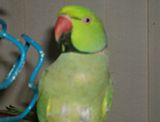woohoo
Moderator: Mods
Cinnamon grey split for blue? Cool.
Males:
25% grey split for cinnamon
25% blue split for cinnamon
25% greygreen split for blue and cinnamon
25% green split for blue and cinnamon
Females:
25% grey
25% blue
25% greygreen split for blue
25% green split for blue
Jim
Males:
25% grey split for cinnamon
25% blue split for cinnamon
25% greygreen split for blue and cinnamon
25% green split for blue and cinnamon
Females:
25% grey
25% blue
25% greygreen split for blue
25% green split for blue
Jim
October is National Tagline Awareness Month
From the picture, she seems too yellow to be a Green Cinnamon. How about a close-up picture? Here's one of my Green Cinnamons, sometimes know as an Isabel.


Jay
Krameri Aviaries
Krameri Aviaries
Jim,
The Sex-Linked Ino gene does not seem to do a good job in blocking out brown melanin (cinnamon) production. This has been observed not only in IRNs but in other species especially the Budgerigar. The term Lacewing was actually coined because of laced patterns of melanin on the flight coverts on Cinnamon-Ino budgie specimens. Some experts even say that up to 20% of melanin is retained in Cinnamon-Ino crossovers.
Non-Sex-Linked (NSL) Ino however almost totally blocks out melanin because this gene codes for the enzyme Tyrosinase which is the initial catalyst on the biosynthesis of melanin. NSL-Ino is sometimes termed as Tyrosinase-Negative albinism (similar to OCA I human albinism) while SL-Ino is Tyrosinase-Positive albinism (similar to OCA IV human albinism).
If you or any other readers are interested with avian genetics, I recommend joining this Yahoo Group http://pets.groups.yahoo.com/group/Gene ... =259663349
We have discussions on topics such as this on a regular basis.
The Sex-Linked Ino gene does not seem to do a good job in blocking out brown melanin (cinnamon) production. This has been observed not only in IRNs but in other species especially the Budgerigar. The term Lacewing was actually coined because of laced patterns of melanin on the flight coverts on Cinnamon-Ino budgie specimens. Some experts even say that up to 20% of melanin is retained in Cinnamon-Ino crossovers.
Non-Sex-Linked (NSL) Ino however almost totally blocks out melanin because this gene codes for the enzyme Tyrosinase which is the initial catalyst on the biosynthesis of melanin. NSL-Ino is sometimes termed as Tyrosinase-Negative albinism (similar to OCA I human albinism) while SL-Ino is Tyrosinase-Positive albinism (similar to OCA IV human albinism).
If you or any other readers are interested with avian genetics, I recommend joining this Yahoo Group http://pets.groups.yahoo.com/group/Gene ... =259663349
We have discussions on topics such as this on a regular basis.
Jay
Krameri Aviaries
Krameri Aviaries




